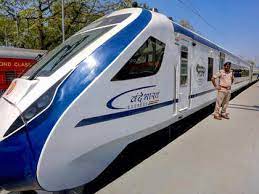What’s in today’s article?
- Why in News?
- About the Vande Bharat Express
- The Vande Bharat Express in Jammu and Kashmir (History, Challenges, Safety and Security, Benefits)
Why in News?
- According to the Union Railway Ministry, a Vande Bharat Express will run between Jammu and Kashmir soon as the work on the 272-km Udhampur-Srinagar-Baramulla Railway Line (USBRL) is completed.
About the Vande Bharat Express:
- Formerly known as Train 18, it is an electric multiple-unit, low cost, semi-high-speed train designed by Research Designs & Standards Organisation (RDSO), manufactured by the Integral Coach Factory (ICF, Chennai) and operated by Indian Railways.
- The cost of a 16-coach Vande Bharat train is about ₹115 crore, while the cost of 8-coach (Mini) train is about ₹70 crore.
- The train has achieved a maximum speed of 180 km/h (110 mph) and went into service on 15 February 2019 (New Delhi- Kanpur-Allahabad-Varanasi route).
- The latest (12 April, 2023) and 15th Vande Bharat Express train will ply between Jaipur and Delhi Cantt railway station.
- It was made with low-cost maintenance and operational optimisation in mind.
●
The Vande Bharat Express in Jammu and Kashmir:
Image Caption: Vande Bharat Express in Jammu and Kashmir
History of the project:
- The first railway line in the former princely state of Jammu and Kashmir was built by the British in 1897 over a distance of 40-45 km between Jammu and Sialkot in the plains.
- After Partition, Sialkot went to Pakistan, and Jammu was disconnected from the rail network of India.
- Until the inauguration of the Pathankot-Jammu line in 1975, the railway station nearest to Jammu and Kashmir was Pathankot in Punjab.
- In 1983, work began on a railway line between Jammu and Udhampur. The project was completed in 2004 and has 20 major tunnels, and 158 bridges.
- With work underway on the Jammu-Udhampur line, the government approved (1995) the extension of the line from Udhampur to Srinagar, and then Baramulla – USBRL project – at an estimated cost of Rs 2,500 crore.
- The project was declared (2002) as a national project on account of its being among the most challenging works undertaken by the Indian Railways after Independence, with the project cost now ballooned to over Rs 35,000 crore.
Challenges and innovations:
- The Himalayas are young and the geologically unstable Shivalik Hills and Pir Panjal mountains lie in the seismically most active Zones IV and V.
- The terrain, which sees heavy snow in winter, presents serious challenges in the construction of bridges and tunnels.
- In view of the challenges in the construction, engineers of the Railways devised a novel Himalayan Tunneling Method (HTM).
- Under this, horseshoe-shaped tunnels were constructed instead of the usual D-shaped ones.
- The site comes down in a curve giving strength to the structure where the soil above it is loose.
- The broad gauge railway line will have 0.5-1% ruling gradient, avoiding the need for bank engines in a mountainous region.
- The trains will be powered by diesel locomotives for now, but there is a provision for electrification in the future.
- Trains can run at speeds up to 100 km/h for the entire length of the journey.
Safety and security:
- All the major bridges, tunnels, and railway stations will be illuminated and have CCTV cameras.
- The track and tunnels have been designed to require as little maintenance as possible.
Development benefits:
- It will bring down the travel time between Srinagar and Jammu to between three and three-and-a-half hours from the five to six hours that it takes by road currently.
- It will provide a reliable and cost-effective all-weather alternative to the Jammu-Srinagar national highway that is frequently shut down by landslides.
- It will facilitate hassle-free transport of goods such as apples, dry fruits, pashmina shawls, handicrafts etc., to other parts of the country in the shortest possible time and at lesser cost.
- Four cargo terminals will be built between Banihal and Baramulla, land has been identified for three of these terminals.
Q1) What is the Research Designs & Standards Organisation (RDSO)?
It is the R&D organisation (1957, Lucknow) under the Ministry of Railways, which functions as a technical adviser and consultant to the Railway Board, the Zonal Railways, etc., in respect of design and standardisation of railway equipment, etc.
Q2) What are MEMU trains?
On Indian Railways, the Mainline Electric Multiple Unit (MEMUs) are electric multiple unit (EMU) trains that serve short and medium-distance routes in India, as compared to normal EMU trains that connect urban and suburban areas.
Source: Tracking the train to Kashmir: How the Vande Bharat is set to transform commute in the Valley
Last updated on June, 2025
→ UPSC Notification 2025 was released on 22nd January 2025.
→ UPSC Prelims Result 2025 is out now for the CSE held on 25 May 2025.
→ UPSC Prelims Question Paper 2025 and Unofficial Prelims Answer Key 2025 are available now.
→ UPSC Calendar 2026 is released on 15th May, 2025.
→ The UPSC Vacancy 2025 were released 1129, out of which 979 were for UPSC CSE and remaining 150 are for UPSC IFoS.
→ UPSC Mains 2025 will be conducted on 22nd August 2025.
→ UPSC Prelims 2026 will be conducted on 24th May, 2026 & UPSC Mains 2026 will be conducted on 21st August 2026.
→ The UPSC Selection Process is of 3 stages-Prelims, Mains and Interview.
→ UPSC Result 2024 is released with latest UPSC Marksheet 2024. Check Now!
→ UPSC Toppers List 2024 is released now. Shakti Dubey is UPSC AIR 1 2024 Topper.
→ Also check Best IAS Coaching in Delhi






















